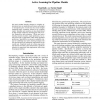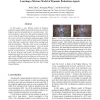41 search results - page 5 / 9 » Real-time agent characterization and prediction |
AAAI
2008
13 years 9 months ago
2008
For many machine learning solutions to complex applications, there are significant performance advantages to decomposing the overall task into several simpler sequential stages, c...
AAMAS
2007
Springer
13 years 7 months ago
2007
Springer
A component-based generic agent architecture for multi-attribute (integrative) negotiation is introduced and its application is described in a prototype system for negotiation abo...
CVPR
2012
IEEE
11 years 9 months ago
2012
IEEE
In this paper, a new Mixture model of Dynamic pedestrian-Agents (MDA) is proposed to learn the collective behavior patterns of pedestrians in crowded scenes. Collective behaviors ...
ICDM
2003
IEEE
14 years 9 days ago
2003
IEEE
The data stream captured by recording inhabitantdevice interactions in an environment can be mined to discover significant patterns, which an intelligent agent could use to automa...
BIOSYSTEMS
2008
13 years 7 months ago
2008
The responses of cortical neurons are often characterized by measuring their spectro-temporal receptive fields (strfs). The strf of a cell can be thought of as a representation of...


